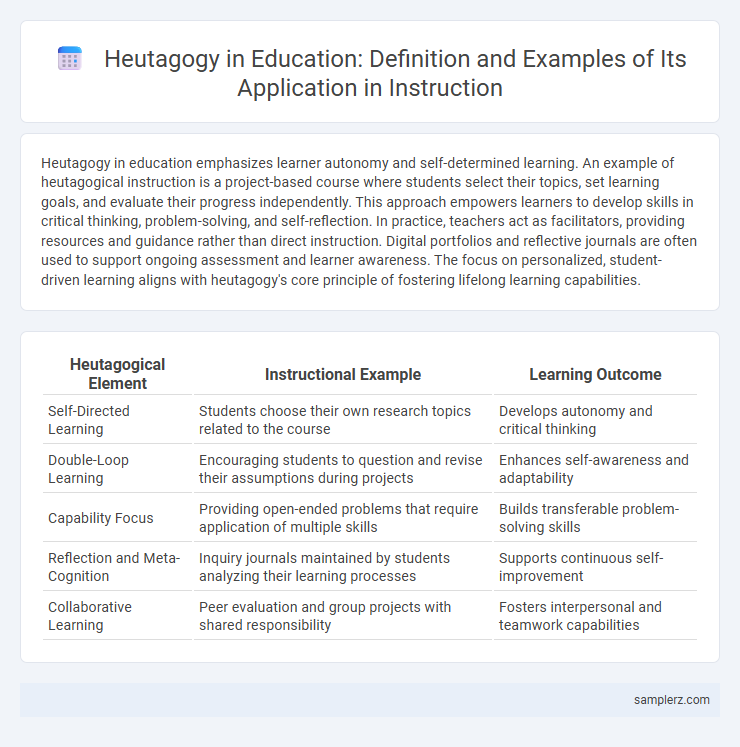Heutagogy in education emphasizes learner autonomy and self-determined learning. An example of heutagogical instruction is a project-based course where students select their topics, set learning goals, and evaluate their progress independently. This approach empowers learners to develop skills in critical thinking, problem-solving, and self-reflection. In practice, teachers act as facilitators, providing resources and guidance rather than direct instruction. Digital portfolios and reflective journals are often used to support ongoing assessment and learner awareness. The focus on personalized, student-driven learning aligns with heutagogy's core principle of fostering lifelong learning capabilities.
Table of Comparison
| Heutagogical Element | Instructional Example | Learning Outcome |
|---|---|---|
| Self-Directed Learning | Students choose their own research topics related to the course | Develops autonomy and critical thinking |
| Double-Loop Learning | Encouraging students to question and revise their assumptions during projects | Enhances self-awareness and adaptability |
| Capability Focus | Providing open-ended problems that require application of multiple skills | Builds transferable problem-solving skills |
| Reflection and Meta-Cognition | Inquiry journals maintained by students analyzing their learning processes | Supports continuous self-improvement |
| Collaborative Learning | Peer evaluation and group projects with shared responsibility | Fosters interpersonal and teamwork capabilities |
Understanding Heutagogy in Modern Education
Heutagogy in modern education emphasizes self-determined learning where students take ownership of their educational journey by identifying goals and sourcing materials independently. This approach fosters critical thinking, adaptability, and deeper understanding, essential for lifelong learning. Educators act as facilitators, supporting learners in developing metacognitive skills and promoting autonomy in complex, real-world problem-solving scenarios.
Key Principles of Heutagogical Instruction
Heutagogical instruction emphasizes learner autonomy by encouraging students to set their own learning goals and engage in self-directed inquiry. Key principles include fostering reflective practice, promoting capability development, and supporting flexible, non-linear learning pathways tailored to individual interests. This approach leverages digital tools and collaborative environments to empower learners in shaping their educational experiences.
Differentiating Heutagogy from Pedagogy and Andragogy
Heutagogy emphasizes self-determined learning where learners take full responsibility for their education, contrasting with pedagogy's teacher-directed approach and andragogy's focus on self-directed adult learners. For example, in heutagogical instruction, students set their own learning goals, choose resources, and evaluate outcomes, highlighting metacognition and capability development. This approach supports personalized, learner-centered education that adapts to complex, real-world problem-solving beyond traditional teaching methods.
Real-World Classroom Examples of Heutagogical Practices
Teachers implementing heutagogical practices often encourage students to design their own projects, fostering self-directed learning and critical thinking. In real-world classrooms, educators integrate technology tools like learning management systems to allow learners to explore topics at their own pace and reflect on their understanding. Peer collaboration and reflective journaling are common strategies that promote autonomy and metacognitive skills within heutagogical frameworks.
Technology Integration for Heutagogical Learning
In heutagogical learning, technology integration empowers learners to take control of their educational journey through tools like interactive simulations, digital collaboration platforms, and adaptive learning software. These technologies facilitate self-directed exploration, critical thinking, and personalized feedback, enhancing learner autonomy and engagement. Platforms such as Moodle, Google Classroom, and AI-driven tutors support the dynamic, learner-centered approach fundamental to heutagogy.
Student-Led Project-Based Learning Models
Student-led project-based learning models empower learners to design, execute, and assess their own projects, fostering autonomy and critical thinking. These models leverage heutagogical principles where students identify resources, set goals, and self-reflect, enhancing metacognitive skills and lifelong learning readiness. Research shows this approach improves engagement, problem-solving abilities, and knowledge retention compared to traditional teacher-led instruction.
Facilitating Self-Determined Learning Environments
Heutagogical instruction emphasizes student autonomy by enabling learners to set their own goals and select resources, fostering self-determined learning environments. Educators act as facilitators rather than traditional instructors, guiding learners through reflective practices and personalized learning pathways. This approach enhances metacognitive skills, critical thinking, and lifelong learning capabilities essential for adapting in dynamic educational contexts.
Assessment Strategies in Heutagogical Instruction
Heutagogical instruction employs self-assessment and reflective journaling to foster learner autonomy and metacognitive skills. Peer feedback and project-based evaluations enable students to take ownership of their learning progress while educators facilitate personalized goal-setting. Digital portfolios provide comprehensive evidence of competency development, aligning assessment with the dynamic, learner-centered nature of heutagogy.
Overcoming Challenges in Implementing Heutagogy
Heutagogy encourages learners to take full responsibility for their educational journey, which can be challenging when shifting from traditional teacher-led models. Overcoming these challenges involves fostering a learning environment that supports self-reflection, metacognition, and intrinsic motivation, enabling students to set their own goals and assess their progress effectively. Providing resources such as flexible online platforms, personalized feedback, and collaborative tools helps educators implement heutagogical practices successfully in diverse educational settings.
Future Trends of Heutagogy in Educational Settings
Heutagogy fosters learner autonomy through self-determined learning, exemplified by project-based tasks where students design their own research questions and learning paths. Emerging technologies such as AI and adaptive learning platforms are poised to enhance personalized learning experiences, supporting the development of 21st-century skills like critical thinking and digital literacy. Future trends in educational settings emphasize integrating heutagogical principles with immersive tools like virtual reality to cultivate lifelong learning and learner agency.

example of heutagog in instruction Infographic
 samplerz.com
samplerz.com